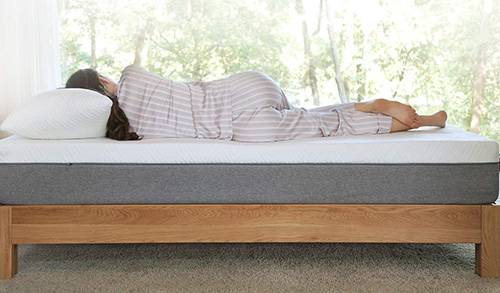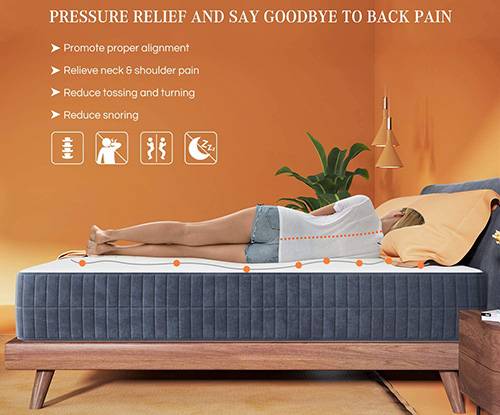If you find yourself tossing restlessly through the night, or and sore, and dragging due to your mental and physical exhaustion- there is a good chance you need a new mattress. Mattress shopping has become both easier, and harder with online buying experiences at the tips of your fingers; on one hand, you can peruse dozens and dozens of choices without leaving your home – but on the other, there are DOZENS and DOZENS of choices to pursue through.
Luckily, blogs like The Sleep Judge exist that narrow down specifics and needs, to help provide you with some quality options without having to research for ages on your own. A popular, yet often overlooked mattress genre is the orthopedic mattresses, a supportive choice for a wide range of ailments. Wondering what an orthopedic mattress is? Take a look at our explanation below.
Orthopedic Defined
The word orthopedic, in reference to mattress comfort, is often thrown around in a manner to boost sales and try to detail the comfort the product provides. But not all mattresses that claim the title are actually orthopedic mattresses. In order to be considered orthopedic, it needs to do two specific things: provide proper spinal alignment and pressure relief to joints. On that note, there are no government regulations or standards associated with the term- so it is up to the buyer to make sure they know what they are looking at.
Orthopedic sleep surfaces are a popular choice for athletes, whose bodies are in a constant state of recovery, those suffering from arthritis or other inflammatory diseases, or those recovering from injury. Good orthopedic choices provide the means for any body shape and weight to find a balance between body support and pressure relief. This relief is often specific to underlying bone and joint pain conditions, or chronic discomfort- not just one or two poor night’s of rest.
— Spine Alignment
When your spine isn’t properly aligned at night, your body will try and make up for it- leaving you feeling stiff and sore, or wake you with pain in the middle of the night. Each sleep position requires specific support, and pillow options to help keep your head and neck aligned with the rest of your spinal column.
Side sleepers need a sleep surface that can help cushion the hips and shoulders, and a supportive, lofty pillow that can provide support to the neck and hold the head in alignment with the spine. Back sleepers need a firmer mattress that helps hold the heavier parts of the body, the hips and shoulders, in alignment, while a thinner pillow helps fill the gap where the neck is, and allow the head to rest. Stomach sleepers are forced to turn their heads, putting themselves out of alignment. They too need a more firm surface, but one that will also cushion the hips without allowing them to sink. Always be sure to take pillow and sleep position into consideration to help choose the best comfort and support for you.
Various materials can help get this done, and the most popular is a memory or latex foam that provides the support needed without compressing too much. Many times using these in layers with a durable innerspring system provides the proper body relief so many need. The point of an orthopedic mattress is to support the body’s weight while providing movement to help absorb differences in shape for proper spinal alignment.
— Pressure Relief
The next thing a true orthopedic mattress needs to be able to do is offer pressure relief without taking the body out of alignment. Many people make the mistake of purchasing a soft surface thinking it will help ease pain in their joints, but end up in worse pain since it is too compressive and creates stress on the spine.
A firmer mattress is a better overall mattress to help hold and distribute body weight. The addition of layers made of various foams and other materials can help cushion and soften the feel against the mattress support. When painful joints are padded and supported without creating uncomfortable body positioning, then it can be classified as an orthopedic option.
Benefits of an Orthopedic Mattress
Obviously, the benefits of this type of mattress are spelled out in the definition provided above. But to recap what this type of mattress can do for you:
- Relieves chronic body pains and underlying pain issues
- Allows you to get a better, deeper sleep uninterrupted by pain or discomfort
- Eliminates mattress compression and sagging, and isolates motion
- Helps support good posture through the night, and true spinal alignment
- Made from materials that are long lasting and durable
- Has a firm underlying support to avoid sagging and provide proper weight distribution
- Helps keep hips and lower back from sinking to alleviate lower back pain that is common with a poorly made, or wrong mattress for your needs
What to Watch Out For
Of course, even though an orthopedic sleep surface sounds ideal, there are a few things you need to think about before buying. First, they are hard to distinguish from other mattresses due to the term orthopedic used as a marketing ploy. You want to carefully research your top choices to help you determine if they are designed for spinal support and pressure relief. One way to help determine this may also be viewed as a con, but price point can often point you in the right direction.
True orthopedic mattresses will use durable material, latex foams, or other foams that they provide information on concerning how they are made. Basically, aht you are looking for is if the company is disclosing the materials and design used, or if they are just tossing out terms and making you dig for further info. Quality materials cost more as well, which is why you may see the higher price point.
Photo credit: fizkes/Shutterstock; Motortion Films/Shutterstock




